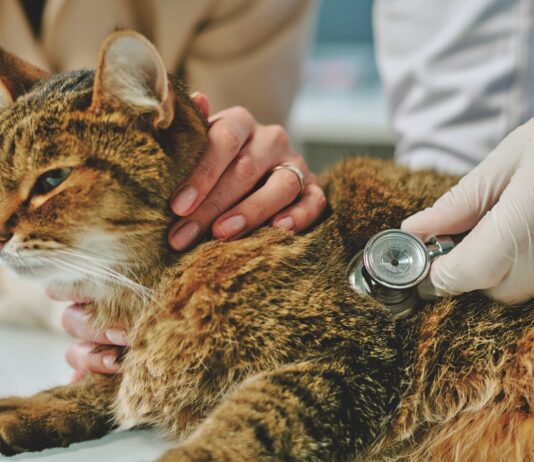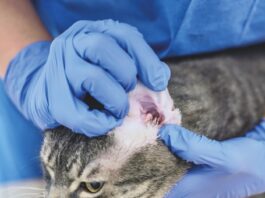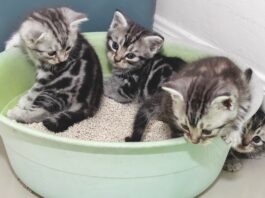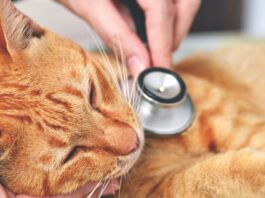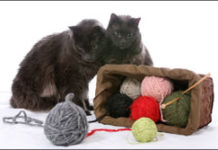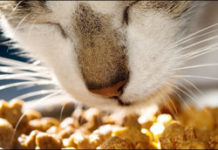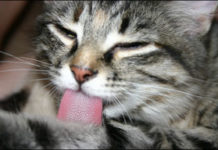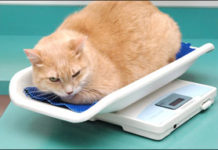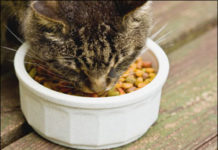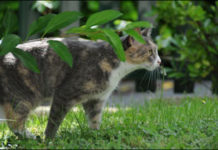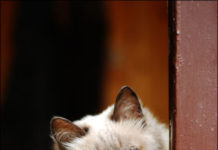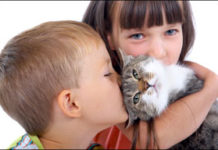Ask Elizabeth: 10/09
One of the main problems is ensuring that the diet is nutritionally balanced. Although it may appear that cats can live and even thrive scrounging for food on their own, a cats nutritional requirements are actually quite complex. When cats eat prey, they ingest the whole animal - and it can be hard to duplicate this "complete" diet with muscle meats and other foods obtained from a grocery store. It also takes a lot of time, expense and knowledge to prepare a well-balanced diet, and many published recipes for home cooked pet diets have been found to be nutritionally incomplete. Even when the diet is balanced, it needs to be prepared so that picky cats cant selectively eat only certain ingredients. Unbalanced Diets & Nutritional Diseases. The veterinary literature is full of documented cases linking improper diets to nutritional diseases, some of which are fatal. Well-meaning owners feeding all-meat diets have caused serious calcium deficiencies resulting in catastrophic bone fractures. While bones contain calcium, feeding cooked bones may cause intestinal blockages or perforations, leading to peritonitis (a potentially fatal infection in the abdomen). Large amounts of tuna fish can cause thiamine (vitamin B1) deficiencies, resulting in neurologic disease (tuna cat foods are supplemented with thiamine to prevent problems). Deficiencies of the amino acid, taurine, result in blindness and cardiomyopathy (a potentially fatal weakness of the heart muscle). Interestingly, while muscle meats contain large amounts of taurine, grinding the meat can reduce taurine levels enough to cause deficiencies.
How to Help Your Grieving Cat
Ever since one of your beloved cats died several weeks ago, youve been feeling pretty down. People who have been through the same experience tell you this is normal after such a loss. But then you notice that your other cat is eating a lot less, doesnt play like he used to and wanders around the house, yowling, as if he was looking for his lost companion. Do cats grieve like we do? And if so, are there things we can do to help them? Animals and Emotions. Its only within the last ten years or so that scientists have begun to recognize that animals lead rich emotional lives. There is evidence that cats and other animals experience emotional responses to significant changes in their environment - and this includes going through the grieving process after the loss of feline or human companions. "What is important for people to realize is that the same brain neurochemistry that allows humans to feel is the same neurochemistry that many animals have - including cats. Cats can mourn," says Katherine Houpt, VMD, PhD, the James Law Professor of Behavior Medicine at Cornell Universitys College of Veterinary Medicine.
Why Is Your Cat Coughing?
A wide variety of irritants from minor and transient to severe and indicative of a major health problem can affect any portion of the feline respiratory system, whose purpose is to warm and humidify inhaled air, deliver oxygen to the lungs, and expel carbon dioxide and other waste gases. A complex pathway of tracts and organs, the upper respiratory system consists of the nose; two nasal passages; the nasal cavity (a hollow structure surrounded by air-filled spaces that are situated just above and below the eyes); and the pharynx (a cavity behind the mouth) that opens, via a passageway called the larynx; to a tubular structure, the trachea, a flexible tube commonly referred to as the windpipe.
Short Takes: 09/09
Governor Linda Lingle, accompanied by State Civil Defense Director, Major General Robert Lee, highlighted the importance of emergency preparedness by showcasing Hawaiis ongoing emergency shelter programs for people with special health needs and pet-friendly shelters. State Civil Defense, working with the State Department of Education, county civil defense agencies, American Red Cross, Department of Health, Hawaiian Humane Society and other public and private sector partners, has designated 158 facilities statewide that may serve as Special Health Needs shelters, and another 55 facilities that may be used as Pet-Friendly shelters. These shelters are located in separate rooms or buildings on public school campuses where general population emergency shelters are also located.
Fur Changes Can Spell Trouble
One of your favorite things about your cat is her sleek, shining fur. Lately, though, it seems like your cat has been having a bad fur day - and she hasnt seemed very interested in grooming herself over the past week or so. Whats going on? "A decline in grooming or a change in the cats fur are some of the subtle signs that your cat may be ill," says Jane Brunt, DVM, of the Cat Hospital At Towson in Baltimore, Maryland. In fact, you can view your cats fur as a barometer of her overall health and well-being. If you do notice a change, report it to your veterinarian so that you can take steps to start treatment quickly. Ilness Indicator. One of the most common fur changes in cats is the loss of hair. You might notice clumps of fur coming out when you pet her, or her fur might just start to look patchy and scraggly. Causes for hair loss - called alopecia - include skin parasites (fleas and mites) and internal parasites (tapeworms or roundworms). These culprits indirectly rob your cats body of vital nutrients.
Feline Blood Donors: Life-Saving
Blood can be the gift of life not just for us, but also for our cats. "A cat suffering severe injury or trauma may require blood transfusions," says Marjory Brooks, DVM, associate director of the coagulation section at Cornell Universitys Animal Health Diagnostic Laboratory. Other indications for transfusion include surgical complications and anemia caused by autoimmune disease, renal failure, chemotherapy, parasites in the intestinal tract or fleas. "Young kittens are especially at risk for blood-loss anemia caused by flea infestation," explains Dr. Brooks. Cats that need plasma proteins to combat liver disease, clotting problems or rat poisoning may also require a transfusion. Qualified Donors. Just like human donors, feline donors are required to take a battery of tests prior to giving blood - and not every cat qualifies. One qualification is weight: A donor cat usually weighs from 10 to 12 pounds. "The bigger the cat, the less risk of hypotension (low blood pressure) after donation," says Dr. Brooks.
Short Takes: 08/09
Baycom Diagnostics, Inc. has developed a cost effective diagnostic kit for monitoring and testing feline and canine diabetes. Currently, veterinarians use hand held glucose meters to test cats and dogs for the potential of diabetes. These meters are a critical part of human diabetes management, yet often do not work well with small animals, are expensive and must be used several times a day. The companys president says veterinarians could administer Baycoms product in a simple, easy test once every 90 days to get an accurate measurement.
Feline Digestive Disorders
Digestive system disorders in general are among the most frequently observed health problems in cats. While many of these disorders are primarily associated with organs such as the liver, pancreas and gall bladder - all of which play a crucial role in the digestive process - plenty of them are centered in the alimentary canal, the long tube leading from a cats mouth to its anus. Most Common. By far the most prevalent feline digestive tract disorder, says Dr. Bartges, is inflammatory bowel disease (IBD). The condition, characteristically evidenced by chronic vomiting and diarrhea, is widely thought to be the consequence of several different disorders involving the feline immune system. The changes that are consistently found upon microscopic analysis in the lining (mucosa) of an affected cats intestines - a superabundance of immune system cells, for example - suggest that abnormal immune system activity may precipitate the disease.
Charges in Melamine Pet Food Recall
ChemNutra Inc., a Las Vegas-based ingredients broker, pleaded guilty on June 16 to federal charges of distributing tainted wheat gluten that led to the mass pet food recalls of 2007. The charges stem from a February 2008 indictment that alleged ChemNutra imported more than 800 metric tons of melamine-contaminated wheat gluten from China between November 2006, and February 2007, then sold the product to various pet food manufacturers.
The Long Arm of the Law
We live in a litigious society. We have laws governing birth, death and the taxes in between, so its no surprise that we also have a host of laws relating to the animals weve taken into our homes. At the federal level, laws generally address issues such as the safety of pet food, the impact of hazardous products on pets, evacuating and transporting pets during emergencies and regulating the use of animals in research. But most of the laws directly affecting our pets are made at the state and local level. These ordinances can differ by city, township and county, and pet owners should contact local officials when getting a new pet or moving to a new place to find out what possible laws pertain.
Recognize Senility in Your Aging Cat
Thanks to advances in veterinary medicine, its not uncommon for a cat to live to the ripe old age of 20 - roughly the physiologic equivalent of age 93 in a human. Thats the good news. The bad news is that cats, like humans, become increasingly susceptible to age-related disease conditions as they grow old, and most of these disorders are bound to have an effect on an animals behavior. For example, arthritis is likely to cause an active cat to slow down dramatically as it transitions through its golden years; kidney and urinary tract disease may affect its litter box behavior; progressive periodontal disease and tooth loss may alter its eating habits; and progressive hearing problems may make a cat decreasingly responsive to its environment. In some cases, however, an elderly cats behavioral peculiarities will remain unattributable to any underlying disease condition. In such a case, the animal is apt to be diagnosed as "senile," a vague term used to describe an animal that exhibits physiologically inexplicable cognitive dysfunction, the outward signs of which resemble those associated with age-related dementia and Alzheimers disease in humans.
Euthanasia: What to Expect and What Questions to Ask First
How can you possibly go on living without your cat - the beloved best friend with whom youve shared your life for the past 10 or 15 years? That is one of the challenging and possibly unanswerable questions that loving and conscientious cat owners must ponder when their veterinarian suggests that they might want to consider euthanasia. The Good Death. The term euthanasia is derived from two Greek words - eu, which means good, and thanatos, which means death. In a report published in 2001, the American Veterinary Medical Association (AVMA) defined this "good death" as follows: "Euthanasia is the act of inducing humane death in an animal. It is our responsibility as veterinarians and human beings to ensure that if an animals life is to be taken, it is done with the highest degree of respect, and with an emphasis on making the death as painless and distress-free as possible."

